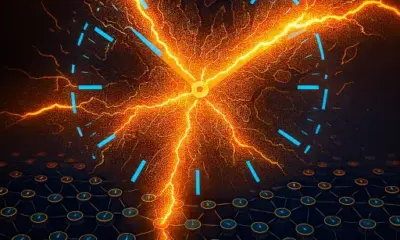Technology
Solidity 0.6.x Enhances Smart Contracts with Try/Catch Functionality

As the blockchain development landscape advances, the release of Solidity version 0.6.x has introduced significant improvements in error handling for smart contracts. Among the most notable enhancements is the incorporation of the try/catch statement, which allows developers to manage exceptions more effectively. This feature not only streamlines error handling but also improves the overall robustness of smart contracts deployed on the Ethereum network.
Understanding the Need for Effective Error Handling
Traditionally, error handling in Solidity relied on methods like require(), assert(), and revert(). While these functions facilitated transaction reversion, they lacked the sophistication required for modern applications that demand efficient debugging and user feedback. The introduction of the try/catch mechanism in version 0.6.x provides a means to handle exceptions from external contract calls and operations that may revert under specific conditions. By improving error handling, developers can protect the integrity of their contracts and prevent potential loss of funds.
Advantages of the Try/Catch Mechanism
The try/catch structure offers several advantages that enhance the development experience:
1. **Enhanced Readability**: The clear separation of normal control flow and error handling improves code clarity.
2. **Granular Error Management**: Developers can catch specific errors, allowing tailored responses such as logging failures or notifying users.
3. **Separation of Concerns**: Isolating error handling from primary contract logic results in cleaner, more maintainable code.
The syntax for the try/catch statement is straightforward and modeled after similar structures found in programming languages like JavaScript and Python. The basic syntax is as follows:
“`solidity
try externalContract.callMethod(parameters) {
// Code to execute if the call is successful
} catch Error(string memory reason) {
// Code to execute when a revert occurs with a string reason
} catch (bytes memory lowLevelData) {
// Code to execute for low-level errors (e.g., out of gas)
}
“`
Demonstration of Try/Catch in Action
To illustrate the functionality of try/catch, we can examine an example involving two contracts: the Caller contract and the Callee contract. The Callee contract includes a function that may revert, while the Caller contract will attempt to interact with it.
**Callee Contract:**
“`solidity
pragma solidity ^0.6.0;
contract Callee {
function riskyFunction(uint _value) public pure returns (string memory) {
require(_value > 10, “Value must be greater than 10!”);
return “Success!”;
}
}
“`
**Caller Contract:**
“`solidity
pragma solidity ^0.6.0;
import “./Callee.sol”;
contract Caller {
Callee callee;
constructor(address _calleeAddress) public {
callee = Callee(_calleeAddress);
}
function executeRiskyFunction(uint _value) public returns (string memory) {
try callee.riskyFunction(_value) returns (string memory result) {
return result; // Return the success message
} catch Error(string memory reason) {
// Handle revert with a reason
return reason; // Return the revert reason for feedback
} catch (bytes memory /*lowLevelData*/) {
// Handle low-level errors
return “A low-level error occurred.”;
}
}
}
“`
In this example, the Callee contract’s **riskyFunction** will revert if the input value is less than or equal to 10. The Caller contract, upon invoking **executeRiskyFunction**, attempts to call **riskyFunction** within a try block. If successful, it returns the success message. If it reverts, the catch Error block captures the revert reason and returns it for user feedback, while any low-level exceptions are handled in a separate catch block.
Best Practices for Implementing Error Handling
To maximize the effectiveness of the try/catch functionality, developers should adhere to several best practices:
– **Limit Usage for External Calls**: Use try/catch primarily for interactions with other contracts where reverts are likely.
– **Integrate Logging Mechanisms**: Implement logging to monitor unexpected behaviors and improve tracking.
– **Conduct Rigorous Testing**: Test contracts across various scenarios to ensure that error handling functions as intended.
– **Provide Clear Messaging**: Offer meaningful error messages that users can easily understand when interacting with contracts.
In summary, effective error handling is vital for developing secure and reliable smart contracts in Solidity. The introduction of the try/catch statement in version 0.6.x has transformed how developers manage exceptions, allowing for clearer and more efficient contracts. By mastering this feature, developers can significantly enhance the user experience and foster greater trust in blockchain applications. Embracing the try/catch mechanism will undoubtedly refine error handling strategies and elevate skills in Solidity development.
-

 Technology5 months ago
Technology5 months agoDiscover the Top 10 Calorie Counting Apps of 2025
-

 Health3 months ago
Health3 months agoBella Hadid Shares Health Update After Treatment for Lyme Disease
-

 Health3 months ago
Health3 months agoErin Bates Shares Recovery Update Following Sepsis Complications
-

 Technology4 months ago
Technology4 months agoDiscover How to Reverse Image Search Using ChatGPT Effortlessly
-

 Technology1 month ago
Technology1 month agoDiscover 2025’s Top GPUs for Exceptional 4K Gaming Performance
-

 Technology3 months ago
Technology3 months agoElectric Moto Influencer Surronster Arrested in Tijuana
-

 Technology5 months ago
Technology5 months agoMeta Initiates $60B AI Data Center Expansion, Starting in Ohio
-

 Technology5 months ago
Technology5 months agoRecovering a Suspended TikTok Account: A Step-by-Step Guide
-

 Health4 months ago
Health4 months agoTested: Rab Firewall Mountain Jacket Survives Harsh Conditions
-

 Lifestyle5 months ago
Lifestyle5 months agoBelton Family Reunites After Daughter Survives Hill Country Floods
-

 Health3 months ago
Health3 months agoAnalysts Project Stronger Growth for Apple’s iPhone 17 Lineup
-

 Technology4 months ago
Technology4 months agoHarmonic Launches AI Chatbot App to Transform Mathematical Reasoning





















